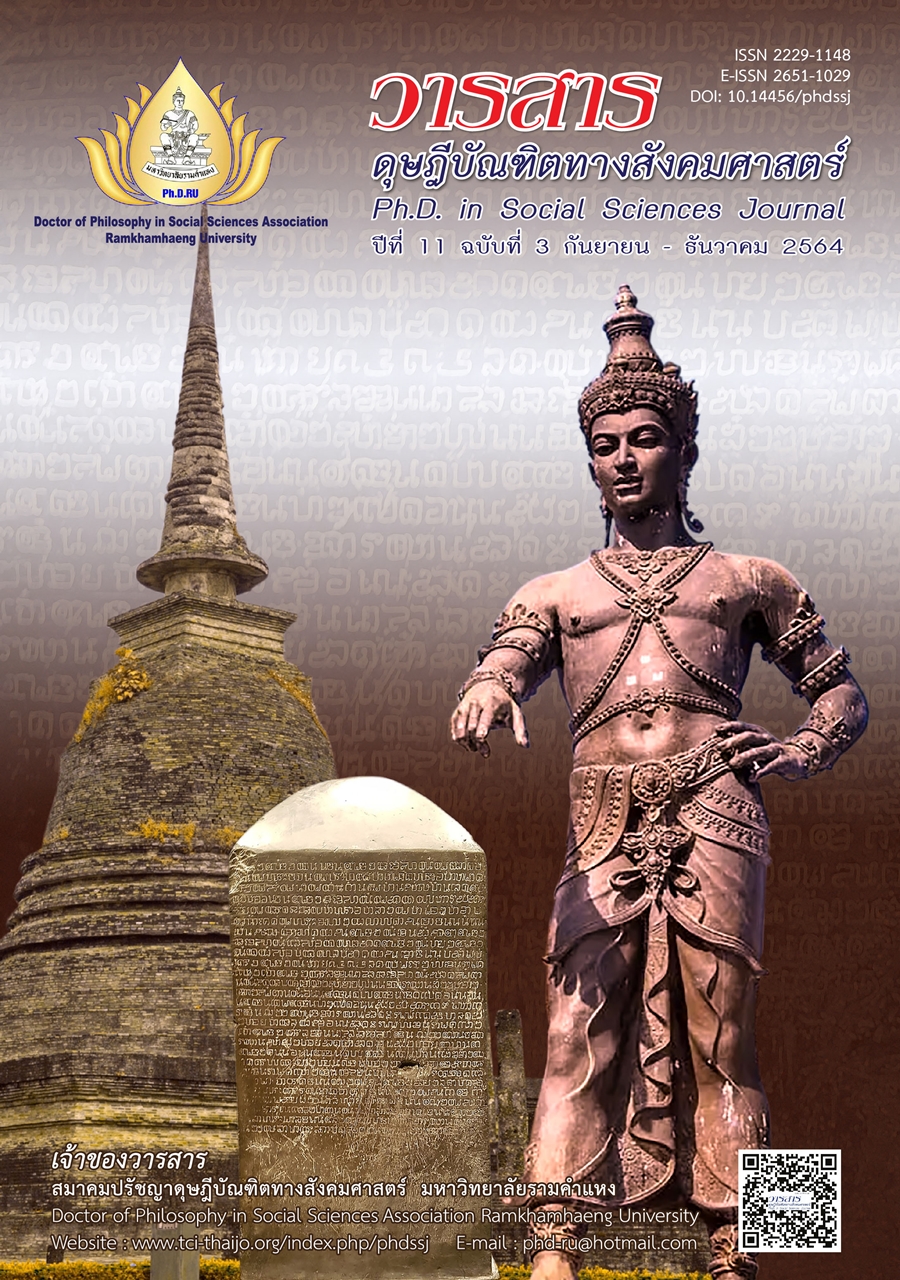อิทธิพลคั่นกลางอนุกรมของการแลกเปลี่ยนความสัมพันธ์ระหว่างผู้นำกับสมาชิก และการให้อำนาจหน้าที่เชื่อมโยงอิทธิพลของภาวะผู้นำเชิงจริยธรรม สู่การแสดงความคิดเห็นของพนักงานองค์การธุรกิจภาคเอกชน
Main Article Content
บทคัดย่อ
บทความวิจัยนี้มีวัตถุประสงค์เพื่อศึกษาการแลกเปลี่ยนความสัมพันธ์ระหว่างผู้นำกับสมาชิกและการให้อำนาจหน้าที่เป็นปัจจัยแผงตัวเชื่อมโยงภาวะผู้นำเชิงจริยธรรมสู่การแสดงความคิดเห็นของพนักงานองค์การธุรกิจภาคเอกชนหรือไม่ อย่างไร รูปแบบใด เป็นการวิจัยแบบผสมผสาน การวิจัยเชิงปริมาณเป็นการเก็บข้อมูลด้วยแบบสอบถามจำนวน 500 ชุด โดยนำผลที่ได้มาทำการวิเคราะห์ประมวลผลด้วยโปรแกรม Smart PLS 3.0 สำหรับการวิจัยเชิงคุณภาพ เก็บข้อมูลจากการสัมภาษณ์ 20 คน การวิจัยเชิงปริมาณและการวิจัยเชิงคุณภาพใช้ตัวอย่างพนักงานองค์การธุรกิจภาคเอกชนในเขตกรุงเทพมหานคร
ผลการวิจัย พบว่า เส้นทางที่มีความเป็นไปได้สูงสุด คือ เส้นทางการแลกเปลี่ยนความสัมพันธ์ระหว่างผู้นำกับสมาชิก และการให้อำนาจหน้าที่เป็นตัวแปรคั่นกลางเชื่อมโยงภาวะผู้นำเชิงจริยธรรมสู่การแสดงความคิดเห็นของพนักงาน เป็นเส้นทางที่มีค่า t สูงสุด เท่ากับ 5.846 (มากกว่า 2.58) และมีนัยสำคัญทางสถิติที่ 0.01 เส้นทางที่มีความเป็นไปได้ถัดมา คือ เส้นทางการให้อำนาจหน้าที่เป็นตัวแปรคั่นกลางเชื่อมโยงภาวะผู้นำเชิงจริยธรรมสู่การแสดงความคิดเห็นของพนักงานองค์การธุรกิจภาคเอกชน เป็นเส้นทางที่มีค่า t เท่ากับ 4.005 (มากกว่า 2.58) และมีนัยสำคัญทางสถิติที่ 0.01 และผลกการวิเคราะห์ข้อมูลจากสารสนเทศที่ได้จากการวิจัยเชิงคุณภาพ ทำให้ผู้วิจัยได้ค้นพบความรู้ใหม่ที่นอกเหนือไปจากกรอบแนวคิดของการวิจัย พบว่า ปัจจัยที่มีอิทธิพลต่อการแสดงความคิดเห็นของพนักงานองค์การธุรกิจภาคเอกชน มีตัวแปรอื่นที่นอกเหนือจากตัวแปรตามกรอบแนวคิดได้แก่ วัฒนธรรมแรงจูงใจในการทำงาน ทัศนคติส่วนบุคคล และบรรยากาศภายในที่ทำงาน
Article Details
บทความวิชาการ บทความวิจัย และบทวิจารณ์หนังสือในวารสารดุษฎีบัณฑิตทางสังคมศาสตร์ เป็นความคิดเห็นของผู้เขียน มิใช่ของคณะผู้จัดทำ และมิใช่ความรับผิดชอบของสมาคมปรัชญาดุษฎีบัณฑิตทางสังคมศาสตร์ มหาวิทยาลัยรามคำแหง (กรณีการทำวิจัยในมนุษย์ ผู้วิจัยต้องผ่านการอบรมจริยธรรมการวิจัยในมนุษย์ และนำหลักฐานมาแสดง)
เอกสารอ้างอิง
Best, J. W. (1977). Research in education (3rd ed.). Prentice Hall.
Blanchard, K., Carlos, J. P., & Randolph, A. (2001). Empowerment takes more than a minute (2nd ed.). Berrett-Koehler.
Brown, M. E., & Trevino, L. K. (2006). Ethical leadership: A review and future directions. Leadership Quarterly, 17(6), 595-616.
Cohen, J. M., & Uphoff, N. T. (1986). World development. McGraw-Hill.
Comrey, A. L., & Lee, H. B. (1992). A first course in factor analysis. Erlbaum.
Cronbach, L. J. (1990). Essentials of psychology testing (5th ed.). Harper Collins.
Detert, J. R., & Burris, E. R. (2007). Leadership behavior and employee voice: Is the door really open. Academy of Management Journal, 50(4), 869-884.
Graen, G. B., Novak, M., & Sommerkamp, P. (1982). The effects of leader-member exchange and job design on productivity and satisfaction: Testing a dual attachment model. Organizational Behavior and Human Performance, 30, 109-131.
Graen, G. B., & Uhi-Bien, M. (1995). Development of Leader-Member Exchange (LMX) theory of leadership over 25 years: Applying a multi-level domain perspective. Leadership Quarterly, 6, 219-247.
Hassan, M., Hassan, I., & Batool, F. (2015). Employee voice behaviour in organisations: Evidence from Pakistan. Asian Journal of Management Science and Applications, 2(2), 195-212.
LePine, J. A., & Van Dyne, L. (2001). Voice and cooperative behavior as contrasting forms of contextual performance: Evidence of differential relationships with big five personality characteristics and cognitive ability. Journal of Applied Psychology, 86(2), 326-336.
Lord, R., & Maher, K. (1991). Leadership and information processing: Linking perception and performance. Unwin Hyman.
Lunenburg, F. C. (2010). Leader-member exchange theory: Another perspective on the leadership process. International Journal of Management, Business, and Administration, 13(1), 1-5.
Piriyakul, M. (2019). Smart PLS for structural equation modeling. Ramkhamhaeng University, Faculty of Science. [In Thai]
Ringle, C. M., Wende, S., & Will, S. (2005). Smart PLS 2.0 (M3) Beta. Retrieved from http://www.smartpls.de
Schriesheim, C. A., Castro, S. L., & Cogliser, C. C. (1999). Leader-Member Exchange (LMX) research: A comprehensive review of theory, measurement, and data-analytic practices. Leadership Quarterly, 10(1), 63-113.
Van Dyne, L., Cummings, L., & McLean, P. J. (1995). Extra-role behaviors: In pursuit of construct and definitional clarity. In L. L. Cummings & B. M. Staw (Eds.), Research in organizational behavior (pp. 215-285). JAI Press.
Van Dyne, L., & LePine, J. A. (1998). Helping and voice extra-role behaviors: Evidence of construct and predictive validity. Academy of Management Journal, 41(1), 108-119.
Yukl, G. A. (1998). Leadership in organizations (4th ed.). Prentice Hall.


